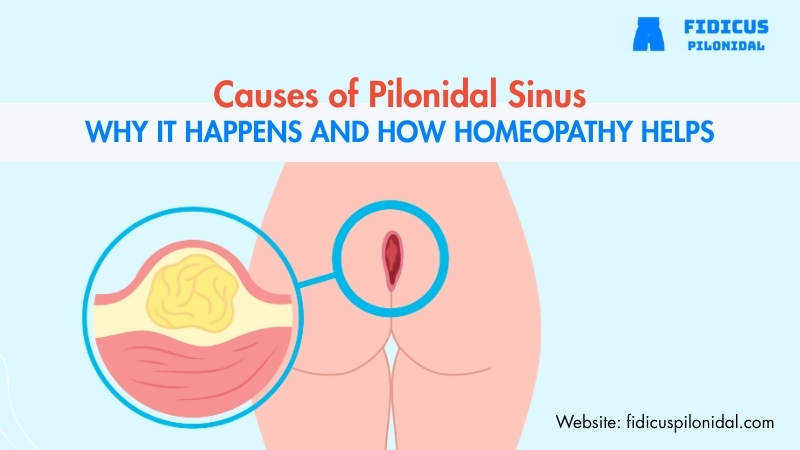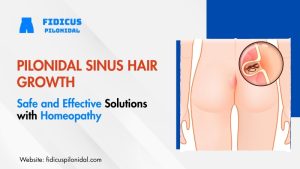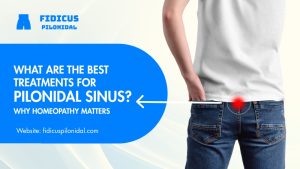Pilonidal sinus is a small cyst or tunnel in the skin, usually occurring near the tailbone, that can cause pain, swelling, and recurrent infections. It often develops when loose hair penetrates the skin, triggering inflammation and pus formation. Common causes of pilonidal sinus include excessive hair growth, poor hygiene, prolonged sitting, friction in the sacrococcygeal area, and a genetic tendency toward deep skin folds. While the condition can be uncomfortable and sometimes recurrent, it is rarely life-threatening.
Homeopathy offers a safe and non-invasive approach to pilonidal sinus treatment by addressing the root causes, reducing inflammation, and preventing recurrence. Remedies are tailored to each patient’s symptoms, overall health, and lifestyle factors, helping to heal the sinus without surgery. With proper care from an experienced homeopathy doctor, patients can experience long-term relief and improved quality of life.
What Is Pilonidal Sinus?
A pilonidal sinus is a small tunnel or tract that develops just beneath the skin, most often located in the natal cleft—the groove between the buttocks, just above the tailbone (sacrococcygeal region). The term pilonidal is derived from the Latin words pilus (hair) and nidus (nest), meaning “nest of hair”. This is because the tract often contains loose hair, dead skin cells, sweat residue, and other debris trapped inside.
The sinus usually begins as a tiny opening or pit in the skin, which may go unnoticed at first. Over time, these hair and skin particles can burrow deeper, triggering an inflammatory reaction. If bacteria enter the area, the sinus can become infected, leading to the formation of a pilonidal abscess—a painful, pus-filled swelling that can cause significant discomfort.
While pilonidal sinus can occur in anyone, certain patterns are clear:
- Age group most affected: Typically between 15–35 years
- Gender difference: More common in men, partly due to thicker, coarser body hair and a greater likelihood of hair shedding
- Body type & lifestyle factors: People with a sedentary lifestyle, deep buttock creases, or high hair density are more prone
- Occupations at higher risk: Drivers, IT professionals, students, and others who sit for long hours
This condition may present as a single short tract or multiple branching sinus tracts. The severity can range from a minor skin opening with no pain to a large, recurrent abscess that interferes with daily activities. If left untreated, a pilonidal sinus can progress from a mild irritation to chronic, recurring infections—which is why early diagnosis and prompt treatment are crucial.
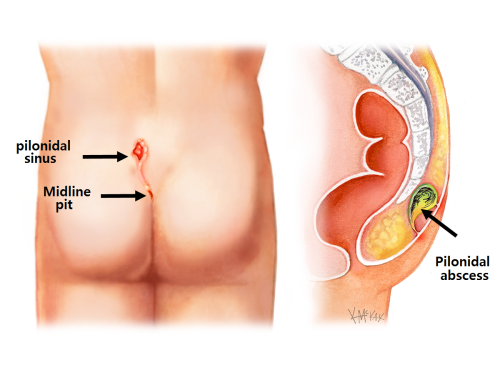
What are the causes of a pilonidal sinus infection?
A pilonidal sinus doesn’t develop overnight—it’s the result of a mix of mechanical factors, such as friction and pressure, and anatomical predispositions, like the depth of the buttock crease or the texture of your hair. These factors combine to create the perfect environment for hair and debris to enter the skin, leading to inflammation and infection.
1. Hair Penetration into the Skin
Loose, shed hair from the scalp, back, or buttock area can easily fall into the natal cleft (buttock crease). Due to friction or pressure, these hairs act like tiny splinters, burrowing into the skin. The body sees these hairs as foreign objects and mounts an immune response, leading to redness, swelling, and pus formation.
Example: People with coarse or curly body hair are at higher risk because such hair is more likely to get trapped.
2. Friction and Prolonged Pressure
Extended sitting—common among drivers, office workers, gamers, and students—increases skin pressure and micro-movements in the buttock crease. This friction can force hair deeper into the skin and cause microscopic skin breaks, making it easier for bacteria to invade.
3. Skin Irritation or Micro-Injury
Tiny cuts, scrapes, or follicle inflammation in the tailbone area can occur from sweating, rubbing against tight clothing, or poor hygiene. These small injuries create entry points for hair and bacteria, eventually forming a sinus tract.
4. Deep Natal Cleft
People with a naturally narrow and deep buttock crease tend to trap hair, moisture, and dirt more easily. This creates an ideal environment for bacterial growth and increases the likelihood of sinus formation.
5. Excess Sweating and Poor Ventilation
Moisture softens and weakens skin, making it easier for hair to penetrate. Tight, non-breathable clothing (like synthetic underwear or trousers) prevents evaporation, keeping the area warm and damp—perfect conditions for infection.
6. Obesity or Overweight
Extra weight deepens the natal cleft and increases skin-on-skin friction, making it harder to keep the area clean and dry. Obesity also slows healing, which can worsen an existing pilonidal sinus.
7. Trauma to the Tailbone Area
A fall, bump, or blow to the sacrococcygeal region can damage skin and hair follicles, triggering inflammation. This can act as the starting point for a pilonidal sinus, especially if the area later becomes contaminated with hair or bacteria.
8. Genetic Tendency
A family history of pilonidal sinus may indicate inherited traits such as coarse hair, oily skin, or certain buttock shapes that increase risk. Even in the absence of obvious risk factors, genetics can make some individuals more prone.
Most pilonidal sinus infections are caused by hair becoming embedded in the skin, aided by friction, pressure, and a warm, moist environment. Over time, bacteria turn this trapped hair into a painful abscess. Recognizing and addressing these causes early—through hygiene, posture changes, and hair control—can greatly reduce the risk of recurrence.
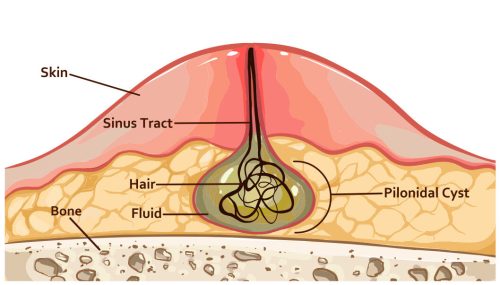
How Infection Develops
A pilonidal sinus infection starts small but can progress quickly if left unchecked. The process typically unfolds in stages:
1. Hair or Debris Gets Lodged Under the Skin
Loose body hair, lint, or dead skin cells collect in the buttock crease. Due to the skin’s natural folds and moisture, these particles can easily settle into small pits or pores near the tailbone.
2. Friction Pushes It Deeper
Daily activities such as walking, bending, or sitting for long periods create constant friction in the area. This repetitive rubbing forces the hair deeper into the skin, similar to how a splinter works its way in.
3. The Body Reacts to a “Foreign Object”
Once inside, the hair is treated by the immune system as a foreign body. White blood cells rush to the site, causing inflammation. This results in redness, swelling, and tenderness around the pit or tract.
4. Bacteria Multiply Inside the Tract
The warm, moist environment of the natal cleft is ideal for bacterial growth.
- Common culprits include Staphylococcus aureus and other skin bacteria.
- As bacteria multiply, they release toxins and enzymes that damage surrounding tissues.
5. Pus Formation and Abscess Development
As the immune system fights the infection, pus—a thick fluid containing dead white blood cells, bacteria, and tissue debris—begins to collect inside the tract. The sinus expands, creating a painful abscess.
6. Symptoms of Pilonidal Sinus Appear
Once the infection is established, patients often notice:
- Pain: Sharp or throbbing, worsens when sitting or moving
- Redness and Swelling: Inflamed skin over and around the sinus
- Discharge: Pus or blood may drain through one or more small openings, sometimes with a foul smell
- Warmth: The area feels warmer due to increased blood flow
- Fever: In severe cases, indicating the body is fighting an active infection
Why Early Action Matters
If untreated, the abscess may burst on its own, temporarily relieving pain but leaving behind a chronic sinus tract that continues to trap hair and debris. This is why early diagnosis and proper care are crucial—not just to stop pain, but to prevent recurrence.
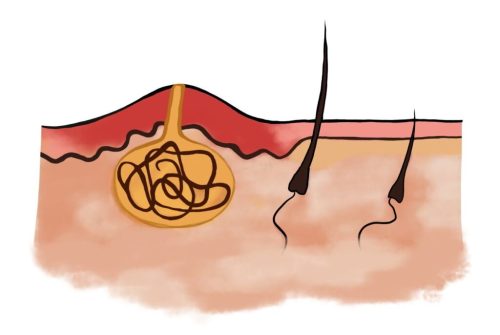
Symptoms of Pilonidal Sinus
The symptoms of Pilonidal Sinus can vary depending on how early the condition is detected and whether infection has developed. Recognizing the signs early can prevent the condition from progressing into a painful abscess.
Early Symptoms (Initial Stage)
At this stage, the sinus tract may not yet be infected, and discomfort can be mild:
- Small Dimple or Pit Above the Buttocks
A tiny opening or shallow depression in the skin, often in the midline above the natal cleft (buttock crease).
This is the earliest visible sign that hair or debris may have entered the skin. - Mild Discomfort While Sitting
A slight, nagging pain or pressure when sitting for long periods—especially on hard surfaces—can indicate the beginning of irritation in the area. - Slight Swelling Without Redness
You might feel a small bump under the skin that’s not yet warm or tender, suggesting a sinus tract is forming but hasn’t become inflamed. - Occasional Itching or Irritation
Due to trapped hair and friction, the area may itch or feel irritated even without visible signs of infection.
Progressive Symptoms (When Infection Sets In)
As the sinus becomes blocked and bacteria multiply, the following symptoms typically appear:
- A Painful Lump That Worsens When Sitting or Bending
The abscess beneath the skin grows larger, causing sharp or throbbing pain that increases with movement. - Redness, Warmth, and Tenderness
Signs of inflammation appear as the body reacts to infection—skin turns reddish and feels hot to touch. - Pus or Bloody Discharge
Thick yellowish pus, sometimes mixed with blood, may drain from one or more small openings in the skin. This is the body’s way of expelling the infection. - Foul-Smelling Drainage
The discharge often has a bad odor, indicating the presence of bacteria and decaying tissue inside the sinus. - Fever and Fatigue (in acute infection)
When the infection becomes more severe, the body responds with fever, chills, and general tiredness as it tries to fight off the bacteria.
Chronic Symptoms (Recurrent Pilonidal Sinus)
If the condition is left untreated or not completely healed, it can become chronic:
- Repeated swelling and discharge cycles
- Multiple sinus openings in the same area
- Scar tissue formation making complete healing harder
Important: Many people ignore early signs thinking it’s a small boil or skin irritation. However, prompt medical evaluation—especially if there’s pain, swelling, or discharge—can prevent the need for surgery and allow for Pilonidal Sinus treatment in homeopathy.
Identifying a Pilonidal Sinus and Recognizing Signs of Infection
A Pilonidal Sinus often starts silently, but over time, small signs become noticeable—especially if infection develops. Understanding these signs can help you seek early treatment and avoid painful complications.
Early Clues You May Have a Pilonidal Sinus
You might suspect a pilonidal sinus if you notice:
- A Visible Pit or Small Hole in the Midline Above the Buttocks
This tiny opening, often found at the top of the buttock crease, may look like a dimple, pinhole, or small pore. It’s the main entrance where loose hairs and debris can get trapped. - Recurrent Pain and Swelling in the Same Area
If you experience discomfort or a lump that flares up periodically—especially after long periods of sitting—it may indicate a chronic sinus tract. - Moisture or Discharge on Clothing or After Bathing
You may spot yellowish pus, clear fluid, or blood stains on undergarments, towels, or after a shower. Sometimes, the discharge is accompanied by a noticeable foul smell. - Multiple Sinus Openings or Branching Tracts
In long-standing cases, more than one hole may form, connected under the skin by branching tunnels, leading to repeated infection and drainage.
Signs of an Active or Spreading Infection
When the sinus becomes infected, symptoms can escalate quickly:
- Redness and Heat Around the Area
The skin turns inflamed and warm as the body responds to bacterial growth. - Throbbing or Sharp Pain
Pain can become constant and severe, especially when sitting, bending, or walking. - Fever and General Malaise
A spike in temperature, chills, or fatigue may indicate that the infection is spreading beyond the local area. - Rapid Swelling
The abscess may enlarge within hours, making it difficult to sit or lie down comfortably.
Why Early Recognition Matters
Ignoring these symptoms can allow the infection to worsen, increasing the risk of repeated flare-ups, larger abscesses, and even the need for surgery. Early homeopathy treatment for pilonidal sinus can help control infection naturally, prevent recurrence, and promote healing without invasive procedures.
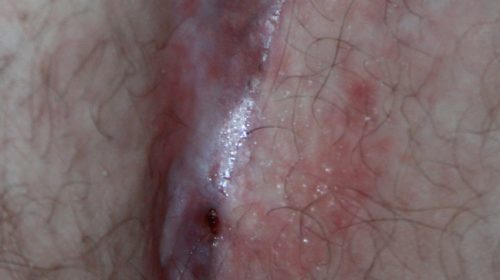
Is Pilonidal Sinus Dangerous?
By itself, a pilonidal sinus is not usually life-threatening, but neglecting it can cause complications that significantly affect comfort, daily activities, and long-term skin health. The danger lies not in the initial sinus tract but in the infections and repeated inflammation it can trigger.
Potential Risks of Ignoring a Pilonidal Sinus
- Repeated Abscess Formation and Chronic Pain
If the sinus remains untreated, bacteria can multiply within trapped debris, leading to pus-filled abscesses. These abscesses are painful, may burst spontaneously, and often recur—making it a chronic problem. - Multiple Sinus Tracts and Scar Tissue
Repeated inflammation can cause the sinus to branch into multiple tracts under the skin. Over time, scar tissue may form, making the condition more complex to treat and increasing the chance of recurrence. - Delayed or Poor Wound Healing
In cases where surgery is performed but hygiene or aftercare is inadequate, the wound may heal slowly, reopen, or become reinfected—prolonging recovery. - Spread of Infection
Untreated infections can spread to surrounding skin (cellulitis) or, in rare cases, deeper tissues, leading to more serious health issues.
Rare but Serious Skin Changes
Very long-standing, untreated pilonidal sinus tracts—especially those with repeated infection for years—can lead to abnormal skin cell changes. Though extremely rare, chronic inflammation has been linked to a small risk of developing a skin cancer known as squamous cell carcinoma, which requires urgent medical attention.
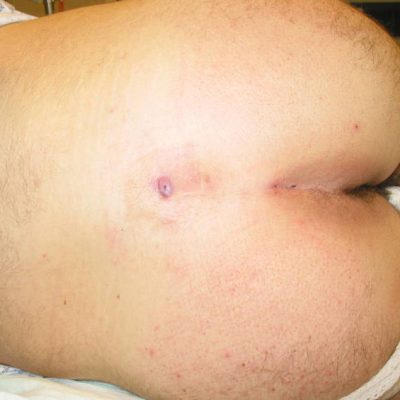
Pilonidal Sinus Treatment in Homeopathy
Pilonidal sinus treatment in homeopathy aims to not only relieve immediate symptoms but also address the underlying causes that make the condition recur. Instead of focusing solely on draining the abscess or removing the tract through surgery, homeopathy works with your body’s natural healing mechanisms to promote long-term recovery.
Key Goals of Homeopathic Treatment
- Reduce Inflammation and Pain Naturally
Gentle yet effective remedies help reduce swelling, tenderness, and redness without the side effects of strong antibiotics or painkillers. - Promote Complete Healing of the Sinus Tract
Homeopathy encourages tissue regeneration, allowing the tract to close and heal from within rather than leaving residual pockets that can flare up later. - Prevent Recurrence
By improving immunity, strengthening skin resistance, and addressing sweat or hair-related tendencies, the chances of developing new tracts are minimized. - Improve Overall Health
Constitutional homeopathy addresses the person as a whole—considering digestion, stress, metabolism, and skin type—ensuring that healing is balanced and sustainable.
Our Approach at Fidicus Pilonidal
At Fidicus Pilonidal, every patient receives personalized treatment after a detailed consultation. We evaluate:
- Lifestyle factors such as sitting hours, physical activity, clothing choices, and hygiene habits.
- Symptom patterns including type of pain, timing of discharge, and triggers for flare-ups.
- Constitutional tendencies like excessive sweating, coarse hair growth, oily skin, or history of skin infections.
Our treatment plan may include:
- Internal homeopathic medicines to target infection, reduce inflammation, and aid tissue repair.
- Guidance on hygiene and self-care to maintain cleanliness and prevent hair from re-entering the skin.
- Nutritional and lifestyle recommendations to support healing and prevent recurrences.
Benefits of Choosing Homeopathy for Pilonidal Sinus
- Non-invasive and painless – No surgical wounds or stitches.
- No downtime – Most patients can continue daily activities during treatment.
- No dependency on antibiotics – Reduces the risk of antibiotic resistance.
Long-term relief – Focuses on the root cause, not just temporary symptom suppression.
Homeopathy Medicine for Pilonidal Sinus
Homeopathy offers a gentle yet effective approach to treating pilonidal sinus by stimulating the body’s healing response and preventing future recurrences. Medicines are never one-size-fits-all—they are carefully chosen based on your symptoms, constitution, and overall health history. Below are some commonly prescribed remedies that homeopathy doctors may consider:
1. Silicea – For chronic sinus tracts with persistent pus
- Helps expel trapped hair and debris from the sinus tract.
- Suitable for cases where pus discharge is thin, watery, or foul-smelling and healing is slow.
- Also strengthens immunity and improves skin resistance to prevent recurrence.
2. Hepar Sulphuris – For extremely painful, sensitive abscesses
- Best for acute flare-ups with throbbing pain and tenderness.
- Useful when the area is highly sensitive to touch and the patient feels chilly.
- Helps bring the abscess to a head and promote quicker drainage.
3. Myristica Sebifera – The “homeopathic knife”
- Known for its powerful action in aiding abscess drainage without surgical intervention.
- Reduces swelling, eases pain, and speeds up the formation of healthy tissue after discharge.
4. Calcarea Sulphurica – For thick, yellow pus and delayed healing
- Works well in cases where healing is prolonged and incomplete.
- Reduces pus formation, clears infection, and encourages healthy tissue regeneration.
5. Graphites – For sticky, foul-smelling discharge with skin irritation
- Best suited for sinus tracts with sticky, honey-like pus and skin that tends to crack or itch.
- Reduces inflammation and soothes irritated skin around the affected area.
💡 Important Note:
Only a qualified homeopathy doctor for pilonidal sinus should decide the right remedy, potency, and dosage after a detailed case-taking process. Self-medication can delay healing and worsen the condition.
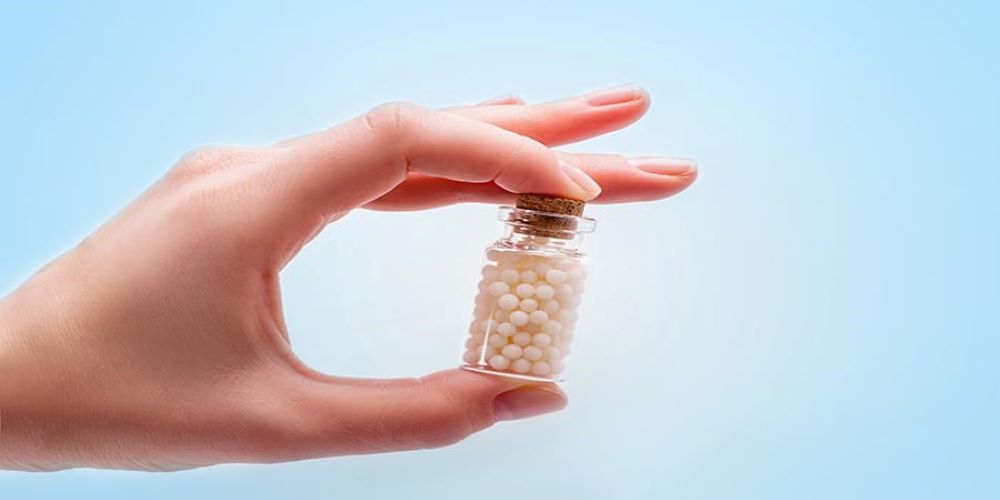
Prevention & Long-Term Care
Even after successful treatment, pilonidal sinus can recur if proper care is not maintained. Prevention focuses on keeping the area clean, minimizing friction, and avoiding factors that trigger inflammation.
Key Preventive Measures:
1. Keep the Area Hair-Free
- Regular trimming, shaving, or safe depilation (with dermatologist-approved creams) reduces the chance of loose hairs entering the skin.
- Consider laser hair removal for long-term prevention, especially in recurrent cases.
2. Maintain Daily Hygiene
- Wash the buttock crease gently with mild antibacterial soap.
- Pat the area completely dry after bathing—moisture can encourage bacterial growth.
- Use talcum powder or antifungal dusting powder if sweating is excessive.
3. Wear Loose, Breathable Clothing
- Avoid tight jeans or synthetic fabrics that trap heat and moisture.
- Choose cotton undergarments to improve ventilation and reduce friction.
4. Avoid Prolonged Sitting
- Take short breaks every 30–45 minutes, especially if you have a desk job.
- Use a cushioned seat or donut pillow to reduce pressure on the tailbone area.
5. Maintain a Healthy Weight
- Excess body weight can deepen the buttock crease, increasing friction and sweat buildup.
- Follow a balanced diet rich in proteins, vitamins, and minerals to support skin healing.
6. Continue Aftercare Even After Symptoms Disappear
- Just because pain and swelling are gone doesn’t mean the sinus is fully healed.
- Continue preventive hygiene and hair removal for at least 6–12 months post-treatment.
- Periodic check-ups with a homeopathy doctor for pilonidal sinus can help track healing and prevent relapse.
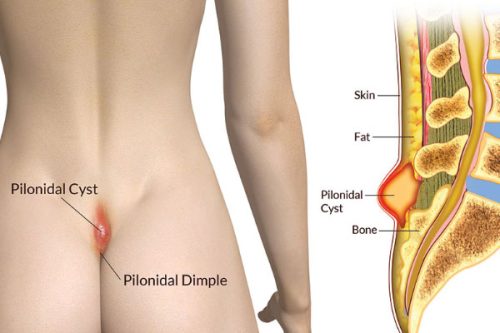
Pilonidal Sinus Treatment in Hyderabad
If you’re looking for Pilonidal Sinus treatment in Hyderabad, Fidicus Pilonidal offers:
- Expert homeopathy doctor for pilonidal sinus
- Individualized plans based on your symptoms and lifestyle
- Focus on both acute relief and long-term prevention
Final Thought
Pilonidal sinus is caused by a mix of hair, friction, sweat, and anatomy, and once infected, it needs prompt care. Conventional treatment can help in emergencies, but homeopathy offers a gentle, personalized approach to reduce recurrences and promote lasting healing.
At Fidicus Pilonidal, we combine medical knowledge with natural care to help you live pain-free.

